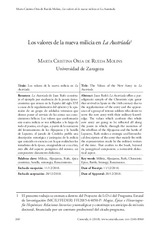Los valores de la nueva milicia en La Austríada
The values of the new army in La Austríada
Autor
Oria de Rueda Molins, Marta C.
Editor
UCOPressFecha
2018Materia
MiliciaAlpujarras
Rufo, Juan, 1574?-1620?
Épica cronística
Batalla
Estrategia
Renacimiento
Militia
Chronistic epics
Battle
Strategy
Renaissance
METS:
Mostrar el registro METSPREMIS:
Mostrar el registro PREMISMetadatos
Mostrar el registro completo del ítemResumen
La Austríada de Juan Rufo constituye el ejemplo por excelencia de la poesía épicocronística que renace en la España del siglo XVI a causa de la regularización del ejército y la aparición de un grupo de soldados veteranos que desean poner al servicio de las armas sus conocimientos bélicos. Los valores que conformarán esta nueva milicia se ven reflejados a lo largo de todo el poema, en el que, a partir de la narración del levantamiento de las Alpujarras y la batalla de Lepanto, el jurado de Córdoba perfila una descripción estratégica y jerárquica de la milicia que coincide en esencia con la que realizaban los tratadistas de la época, otorgándole así a su obra, más allá del aspecto panegírico del mismo, un componente claramente didáctico. Juan Rufo’s La Austríada offers a paradigmatic sample of the Chronistic epic genre that revived in Spain in the 16th century due to the regularization of the army and the appearance of a group of veteran soldiers who desire to serve the new army with their military knowledge. The values which conform this whole new army are going to be reflected all along the poem in which, through the narration of the rebellion of the Alpujarras and the battle of Lepanto, Rufo makes a strategic and hierarchical description of the army that mainly fits with the representation made by the military writers of the time. That confers to the book, beyond its panegyrical component, a noticeable didactical aspect.

